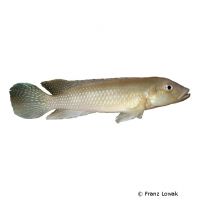Congo Lamprologus (Lamprologus congoensis)
| Congo Lamprologus Lamprologus congoensis | |
|---|---|
| Name | Congo Lamprologus |
| Name Lat. | Lamprologus congoensis |
| Family | Cichlids |
| Family lat. | Cichlidae |
| Order | Cichlids |
| Order lat. | Cichliformes |
| Origin | Congo |
| Habitat | Streams, rivers |
| Diet | Carnivore |
| pH | 7.0-8.0 |
| Behavior | Aggressive |
| Keeping | Pair, harem |
| Care Level | Moderate |
| Reproduction | Cave spawner |
| Breeding | Moderately difficult |
| Life Span | 6-8 years |
| Protection | No |
| Metric Units | |
| Size | 10-13 cm |
| Temperature | 25-27 °C |
| Hardness | 5-15 °dH |
| Aquarium | ~ 250 l |
| US Units | |
| Size | 4"-5" |
| Temperature | 77-81 °F |
| Hardness | 89-267 ppm |
| Aquarium | ~ 65 gal |
Distribution and habitat
The range of the Congo Ground Cichlids is the upper Congo and the rapids area below Pool Malebo (formerly Stanley Pool) in the Congo Basin. There they prefer to live in the strong current of fast flowing streams and small rivers.
Maintenance
The aquarium should be structured with some plants, large river pebbles and roots, have numerous caves, crevices and shelters and offer plenty of swimming space. A substrate covered with gravel and stones and a very strong current is ideal
No ammonia, ammonium and nitrite should be detectable, the nitrate value should not exceed 100 mg/l. To ensure the water quality and oxygen content, a filter and heater adapted to the aquarium size is required, as well as lighting for the species-appropriate day-night rhythm of the animals.
Diet
In nature they feed mainly on insects, insect larvae and small crustaceans. The food supply consists of live, frozen and dry food. For a balanced diet, feed once a day with a high-quality dry food for cichlids (flakes, granules, pellets) as well as cyclops, daphnia, artemia, mosquito larvae, etc. (live or frozen)
It is recommended to feed small portions several times a day. Only feed as much as will be eaten within a few minutes. A regular and varied diet promotes health and prevents deficiency symptoms.
Behaviour and compatibility
They should be kept in pairs or better in a harem, one male with several females. Especially males behave very territorial within the species, but are also aggressive towards other fish close to the bottom. Keeping several harems is only recommended in a much larger and richly structured tank. A socialization with not too small, surface-oriented fish is well possible.
Basically, only compatible fish species with similar demands on water quality and water temperature may be socialized.
Sex dimorphism
The male is much larger, has numerous shiny spots on the sides and dorsal fin, and develops a forehead hump with age.
Reproduction and breeding
They are polygamous cavity breeders. The female occupies a cave and defends it against other females. She attaches up to 80 eggs mostly to the cave ceiling or walls. The female performs brood care and defends her cave, which she does not leave. The fry hatch after 2-3 days and swim free after 8-10 days. The male defends the entire territory with the breeding burrows of his harem
Fry must be fed several times a day with special rearing food (Artemia nauplii). Breeding is hardly possible in community tanks, as the fry are easy prey.
Important
They are not burrowers. A strong current (flow pump) in the aquarium helps to reduce the intra-species aggressiveness of the Congo ground cichlids
They are well adapted to life in the strong current with their streamlined body, strong pectoral fins and large caudal fin
The well-being of the fish should be monitored regularly. Temperature should be checked daily, pH, hardness and nitrate levels at least fortnightly. Regular partial water changes are recommended, even if the pollutant load has not yet reached the upper limit. Sudden changes in water quality should be avoided. Newly introduced fish must be accustomed slowly to the water in the aquarium.
Further literature can be found in your pet store.
References
Text: petdata; Image: Franz Lowak
Source: BMELV (1998): Tierschutzgutachten - Haltung von Zierfischen (Süßwasser); BAENSCH & RIEHL (2004): Aquarien Atlas Bd. 2, Mergus Verlag; ENGELMANN (2005): Zootierhaltung - Tiere in menschlicher Obhut: Fische, Verlag Harri Deutsch
- Gemäß § 21 Abs. 5 Tierschutzgesetz idgF
